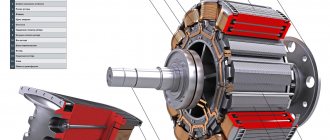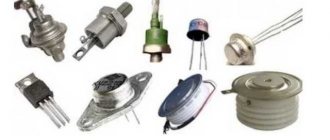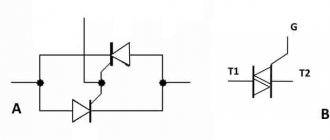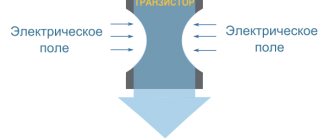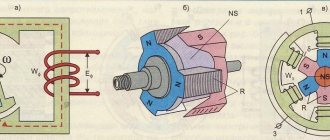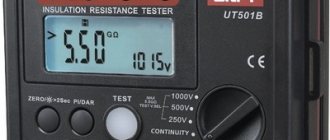Many who use gas stoves know about such a convenient thing to use around the house. A piezo lighter hanging next to the stove replaces hundreds of boxes of matches.
Opening the gas, we bring the spout with contacts to the burner and press the button. There is a crackling sound of an electric spark and the gas lights up with an even blue flame. But what's inside the lighter? Let's take it apart and see
Wires and a piezoelectric element block are laid inside the plastic case. In this model, the stripped strands of a single-core copper wire stick out as the electrodes of the arrester. The main element is a piezoelectric element block:
It increases and transmits pressure from the button to the piezoelectric element. As in the classic lever, we lose in movement but gain in strength. The higher the force applied to the piezocrystal (up to the breaking point), the higher its polarization. Let's look at the piezoelectric element itself:
Structurally, it is made in a polyethylene body in the form of two piezoelectric cylinders connected in parallel, the middle is one pole and is led to the spark gap by a wire, the second electrode is the body, those areas on which the lever presses.
In order to evenly distribute the load on the end of the piezoelectric, steel disks are installed.
How can a piezo lighter be used for other purposes?
Firstly, it can be used as a high voltage source in electrostatics experiments (voltage about 15,000 volts).
Secondly, a click of such a piezo lighter on the electronics (and its spark energy is greater than in low-power pocket gas piezo lighters) will certainly disable it, and there will be no external traces left, everything will look like an electrical breakdown. So, for example, you can disable your boss’s mobile phone by clicking on the data cable connector.
Description and properties [edit | edit code ]
Piezoelectrics are crystals (piezocrystals) that have (endowed) the property of producing an electric charge when compressed (direct piezoelectric effect) or the inverse property of changing shape under the influence of electrical voltage: compressing/expanding, twisting, bending (inverse piezoelectric effect).
Piezoelectricity was discovered by the brothers Jacques and Pierre Curie in 1880-1881. [1]
Actuators - convert electrical energy into mechanical energy.
Sensors (sensors, generators), on the contrary, convert mechanical energy into electrical energy.
There are single-layer, double-layer and multilayer piezocrystals.
Single-layer - under the influence of electricity they change in width, length and thickness. If they are stretched or compressed, they generate electricity.
Double-layer - can be used as single-layer, can be bent or extended. "Flexors" create the greatest amount of movement relative to other types, and "expanders", being more elastic, develop much more force with much less movement.
Multilayer - develop the greatest force with minimal movement (change in shape).
Principle of operation
The effect of the piezoelectric element is most clearly seen in the example of a push-action lighter. When you press a key, the lighter produces a series of sparks, which indicates the most successful use of a piezoelectric generator in this design. To imagine the principle of operation, it is recommended to consider the diagram of a simplified model of this device. It is made in the form of a support with a lever that creates a large force acting on the piezoelectric element.
The elements themselves are solid cylindrical structures, at the ends of which electrodes are located. They are in contact with each other, so they are subject to the same force. The orientation of each piezoelectric element to each other is made in such a way that the electrodes of the contacting surfaces have one charge, for example, positive, and the opposite ends have a charge with a different sign. The connection order must be followed, especially when making such a device with your own hands.
Under the action of the lever, the electrodes close, and an electrical parallel connection of each piezoelectric element occurs. From the point of contact, a current conductor with a rounded tip is removed, located from the metal base at a certain distance. When the lever is pressed, the air gap between the base and the tip is pierced by an electric spark. Now it’s clear how such a lighter works. With further pressing, the force increases, which leads to the appearance of a second and subsequent sparks. This will happen until the piezoelements are completely destroyed.
Description and properties [edit | edit code ]
Piezoelectrics are crystals (piezocrystals) that have (endowed) the property of producing an electric charge when compressed (direct piezoelectric effect) or the inverse property of changing shape under the influence of electrical voltage: compressing/expanding, twisting, bending (inverse piezoelectric effect).
Piezoelectricity was discovered by the brothers Jacques and Pierre Curie in 1880-1881. [1]
Actuators - convert electrical energy into mechanical energy.
Sensors (sensors, generators), on the contrary, convert mechanical energy into electrical energy.
There are single-layer, double-layer and multilayer piezocrystals.
Single-layer - under the influence of electricity they change in width, length and thickness. If they are stretched or compressed, they generate electricity.
Double-layer - can be used as single-layer, can be bent or extended. "Flexors" create the greatest amount of movement relative to other types, and "expanders", being more elastic, develop much more force with much less movement.
Multilayer - develop the greatest force with minimal movement (change in shape).
Piezogenerators. Device and operation. Features and Application
With the development of technology, humanity begins to waste less and less energy in vain. Solar panels, wind power plants, solar concentrators, piezoelectric generators, supercapacitors and other devices have appeared that help people obtain alternative energy and save it. Most of these devices are already used in everyday life.
But science does not stand still; soon it will be possible to obtain energy through everyday and minor movements. This can be done using piezoelectric generators. It is quite enough to quickly charge your phone or player. Piezoelectric generators may also appear that will recharge, for example, a wristwatch using the excitation transmitted by the heartbeat.
Device
In recent years, several prototypes of piezoelectric generators have been created for various applications. They can be combined into two different classes, which differ in the type of vibrations, longitudinal and transverse.
Piezogenerator operating according to a longitudinal oscillation pattern. In this device, a single piezoelectric element is mounted in the lining of a shoe; it allows one to generate a certain amount of energy during rapid movement, for example, when a person runs. This device was invented at Louisiana Tech University and was made in the form of a special spiral plate piezoelectric element.
At the moment, it is difficult to ensure the reliability and durability of such a device due to the fragility of the piezoceramic material. However, this idea can be productive when using flexible piezopolymer plates. But such materials are currently at the research stage.
Piezoelectric generators operating on bending vibrations are no less promising. They may also differ in their configuration and design.
For relatively high-power power sources, prototypes of macropiezoelectric generators of various designs have been created. The most advanced developments of this class of devices include an experimental system of energy storage devices, created on the basis of piezoelectric generators, which are built into the flooring of ticket terminals at the entrance to the Marunouchi metro station (Tokyo).
A known device is an explosive piezoelectric generator, which includes:
- Initiation device:
- Shock wave generator:
- Piezoelectric transducer made of a set of piezoplates connected in parallel:
- The electrodes, which are deposited on opposite faces of the piezoplates, are located perpendicular to the output surface of the shock wave generator:
- The block of piezoplates is placed in a cylindrical volume, the end part of which coincides with the surface of the shock wave generator:
- The shock wave generator appears as an axially symmetrical structure, it is made of an explosive layer, a conical aluminum liner and a conical aluminum cover.
Operating principle
The piezoelectric effect, which is used in piezoelectric generators, consists in the fact that the device has a special dielectric to which mechanical stress is applied. As a result, the dielectric at the two different ends creates a potential difference. As a result, by creating pressure on such a piezoelectric element, it is possible to obtain an electrical voltage of a certain value at the output.
The piezoelectric effect can also cause a reverse transformation, that is, ensure the conversion of electrical energy into mechanical energy, for example, to create sound emitters. Based on the type of relationship used between the polarization vector of the piezoelectric element and the direction of mechanical vibrations, piezogenerators can be divided into classes with transverse and longitudinal directions of mechanical action.
If we consider the physics of the processes that occur in piezoelectrics in more detail, then everything looks quite simple. To do this, you only need to understand the principles of energy generation by piezoelectric materials:
- When a piezoelectric element is subjected to mechanical action, a displacement of atoms in its material, that is, in an asymmetrical crystal lattice, is observed.
- This displacement leads to the appearance of an electric field, which leads to the induction of charges on the electrodes of the piezoelectric element.
Unlike a standard capacitor, the plates of which are capable of retaining charges for a very long time, the induced charges of a piezoelectric generator are retained until the mechanical load ceases to act. It is during this period that energy can be obtained from the element. As soon as the load is removed, the induced charges disappear.
The phenomenon of piezoelectricity was discovered by the brothers Pierre and Jackson Curie in 1880, since then it has become widespread in measuring technology and radio engineering. The term “piezoelectric generators” characterizes only the direction of energy conversion, and not the conversion efficiency. It is the phenomenon associated with the generation of electricity in the event of mechanical impact that engineers and inventors have become interested in in recent years.
Reports began to appear about the possibilities of obtaining electrical energy using the influence of various mechanical energies:
- Movement of waves and wind.
- Exposure to street noise.
- Loads from moving cars and people.
- Heartbeat and so on.
Based on all these options, various inventions began to be invented. Many of them have already found application, and some are currently in the plans, since the technology has not reached the required level.
Applications and Features
Currently, there are several options for the practical use of piezoelectric generators in:
- Piezo lighters with the aim of high voltage on a special spark gap from the movement of a finger. Today, any smoker can carry his own “power station” in his pocket.
- As a sensitive element in the receiving elements of sonars, microphones, pickup heads of electrophones, hydrophones.
- A contact piezoelectric fuse, for example, for shots from an RPG-7 grenade launcher.
- Sensors in the form of a force-sensitive element, for example, gas and liquid pressure sensors, force measuring sensors, and so on.
The inverse piezoelectric effect can be used in:
- Piezoceramic sound emitters, for example, musical cards, all kinds of sirens, which are used in a wide variety of household devices from standard wristwatches to kitchen appliances.
- Ultra-precise positioning systems, for example, a positioner for moving the hard drive head, in a scanning tunnel microscope in a needle positioning system.
- Sonar emitters (sonars).
- Ultrasonic emitters for ultrasonic hydrotreating (industrial ultrasonic baths, ultrasonic washing machines).
- Piezoelectric motors.
- Inkjet printers for ink supply.
- Adaptive optics for the purpose of bending the reflecting surface of a deformable mirror.
The inverse and direct effect of piezoelectric generators are simultaneously used in:
- Sensors based on special surface acoustic waves.
- Ultrasonic delay lines of special electronic equipment.
- Devices based on the effect of special surface acoustic waves.
- Piezotransformers for the purpose of changing high frequency voltage.
- Quartz resonators used as a frequency standard.
Most of the piezoelectric generators used produce a small current. Individual piezoelements can generate high voltage, which breaks through the discharge gap, then the current flows to the rectifier, and then into a storage device, for example, an ionistor.
Advantages and disadvantages
Among the advantages of piezoelectric generators are:
- Long service life.
- Small dimensions.
- Mobility.
- No waste and no environmental pollution.
- Independence from weather and natural conditions.
- Does not require the allocation of additional space.
- Wide applicability of piezoelectric generators in a wide variety of devices.
- Excellent solution as a source of electrical charges, insulation monitoring, high voltage source for ignition purposes and many others. In some cases, the use of piezoelectric generators is advisable as micropower power sources. The maximum voltage that piezoelectric generators can produce in most cases does not exceed 1.6 V, which is quite enough for small light sources, mobile players or mobile communication devices.
Among the disadvantages of piezoelectric generators are:
- Small current. The piezoelectric generator is a converter, but not a source of electricity.
- Generation of electric charge only at the moment of mechanical impact. The current flow is short-term, which requires the introduction of additional elements into a number of devices. As a result, the design becomes more complicated, and therefore loses its reliability.
- At the current time, piezoelectric generators cannot be used to power powerful devices.
Prospects
- The development of technology in the near future will make it possible to use piezoelectric power generators if it is impossible to use solar panels. They will be able to effectively replace them, which will require wind, sea or muscle power. The generated energy will be enough to charge the batteries of tablets, laptops and possibly power an entire house.
- Today, experiments are being carried out to create systems with piezoelectric generators that could receive energy from moving vehicles. According to scientists, a kilometer of highway can generate electrical power equal to 5 MW. However, at the moment, a breakthrough in this area of alternative energy is being stopped by insufficient development of technology.
- In the foreseeable future, it will be possible to recharge a player, mobile phone or other device by simply putting it in your pocket. And a person’s heartbeat can become a source of current, for example, for a portable blood pressure sensor. Such revolutionary prospects are being offered by the creation of flat, miniature “nanogenerators” that can, when shaken, bent or squeezed, produce the same voltage as a standard AA battery.
History [edit | edit code]
In the 1950-1960s in the USSR, the All-Union Scientific Research Institute of Piezo-Optical Mineral Raw Materials, which published annual scientific works, was studying piezoelectricity.
Structurally, the piezoelectric element is a piezoceramic with applied electrodes. Piezoelements can be of various shapes: in the form of disks, rings, tubes, plates, spheres, etc. For vibrators and generators, piezoelements are combined into a piezoelectric stack to achieve better characteristics.
Application
Any piezoelectric element can be used in modern technical devices for various purposes. They are used as quartz resonators, miniature transformers, piezoelectric detonators, high stability frequency oscillators and many other applications. Each device is designed in such a way that it can use not only crystalline quartz, but also elements made of polarized piezoceramics.
However, the piezoelectric element is not limited to lighters. Currently, work is underway to solve the problem of how to make the use of these materials more productive. This principle has been used for a long time on dance floors and parking lots, where mechanical energy is converted into electrical energy under pressure.
In the future, it is possible to install more powerful energy production systems. Currently, small-sized generators are being developed, based on aluminum nitride, which has successfully replaced the traditional lead zirconate titanate. This device is essentially a wireless temperature sensor capable of accumulating energy from various vibrations and transmitting the received data at set intervals.
Currently, converters based on piezoelectric elements are installed on jet aircraft. This technical solution makes it possible to save up to 30% of fuel resources using vibrations of the wings and the fuselage itself. Experimental traffic lights have been created that run on batteries charged by air vibrations caused by city noise.
In the future, these developments will help eliminate the capacity shortage. With the help of piezoelectric elements, it will be possible to generate electricity as a result of the movement of cars along specially equipped tracks. Even ten kilometers of such a piezoelectric road will produce about 5 MW/hour. Sidewalks for pedestrians will also contribute to the production of electricity. This direction is very interesting and promising, attracting the attention of scientists from many countries.
In recent years, the direction of piezoelectric instrumentation has received new development, associated with the creation of piezoelectric converters for generating electrical energy through the use of mechanical energy of deformation, movement of structures and the movement of vehicles and people.
The introduction of a new technology for the manufacture of film piezoelectric elements with a thickness of 5 to 100 microns and the implementation of technology for their automatic assembly into multilayer structures makes it possible to produce piezoelectric generators with optimal parameters that ensure matching of their impedance with the load impedance and output voltages from 2-10 to 240-300 V [—]. The design of the piezoelectric generator is determined by the design of the piezoelectric element.
Piezoelements, in which the direction of polarization coincides with the direction of mechanical force, are used to create powerful piezoelectric generators for voltages of 100-300 V. Piezoelements of the bending type (bimorphs), in which the direction of polarization is perpendicular to the direction of deformation during vibration, are used to create mini-piezoelectric generators for voltage 2-10 V.
As a rule, powerful piezoelectric piezogenerators are converters of mechanical energy (with a pressure of at least 1-2 kN) into electrical energy under cyclic loading, while the alternating voltage is converted using bridge rectifiers into direct voltage. Since the piezoelectric transducer operates for long periods of time with relatively little electrical energy produced per cycle, an energy storage system is typically used (Figure 1). To stabilize the output voltage of the piezoelectric generator at a given level, a feedback system, a special controller, is used. The controller also ensures that the impedance of the piezoelectric generator is matched with the output impedance of the energy consumer.
Rice. 1. Power module block diagram
The basic design of a piezoelectric microtransducer based on a piezobimorph is shown in Fig. 3.
Rice. 3. Principal design of a microtransducer based on a piezobimorph
Nissan Electric (Japan) has developed and produces a power module based on a piezobimorph, which generates energy when a person walks (power ≥20 mW).
EnOcean announces the development of a battery-free radio lighting switch.
The results of studies of a mini-piezoelectric generator for powering the TKR implantable prosthesis at pressure with a power of up to 225 μW are presented (the power consumption of the power supply system for the microcontroller of the TKP PIC161E872 prosthesis is 50 μW).
In [—] the results of studies of a piezoelectric generator implanted into a human knee prosthesis to stimulate bone tissue growth (power up to 250 μW) are presented.
In England, Facility Architects, together with the Scott Wilson Group, is implementing the Pacesetters project to convert the mechanical energy of passenger movement at Victoria Station (34 thousand people pass in 60 minutes) into a source of electrical energy. The authors of the project believe that the system can receive 3-4 watts from each passing person. A similar development is being carried out by specialists from the Japanese railway company JR-East together with scientists from Keio University. The system they created can be used to count passengers and at the same time generate electricity from people passing through the turnstile. The experiment showed that at Shibuya Station, the system produces 1 W/h during 6 hours of operation.
The English company Pavegen Systems has developed a Pavegen piezoelectric generator, which converts energy from the pressure of human steps into electricity (with a deformation of 5 mm, 2.1 W is obtained). The generator board is made of stainless steel coated with rubber. The outer casing is made of cast aluminum. The resulting energy is stored in injection molded polymer batteries and can be used to power lighting fixtures. Five of these generators, installed on a busy section of sidewalk, can supply lighting power to a bus stop for the entire night. According to economists, the payback period for this device is about a year, while the declared resource is five years or 20 million steps.
Gritsenko Anatoly, Nikiforov Viktor, Shchegoleva Tatyana
Literature
(in the source):
- the ability of some materials to generate an electrical charge in response to applied mechanical stress.
Piezoelectric crystals
exhibit
a piezoelectric effect
.
This effect has two properties: The first
is the direct piezoelectric effect, which means that the material has the ability to convert mechanical deformation into electrical charge.
The second
is the opposite effect, in which the applied electrical potential is converted into mechanical strain energy.
The piezo element of a lighter is an example of this effect.
Piezoelectric effect
Piezoelectric substances ( piezoelectrics
), in particular piezoceramics, have the property that when deformed under the influence of external mechanical pressure, electrical charges arise on their surface.
This effect is called the direct piezoelectric effect
and was discovered in 1880 by the Curie brothers.
Soon after this (in 1881), the inverse piezoelectric effect
, namely, that a substance located between two electrodes reacts to an electrical voltage applied to it by changing its shape. The first effect is currently used for measurements, and the second is used to excite mechanical pressures, deformations and vibrations.
More detailed studies of the piezoelectric effect showed that it is explained by the property of the unit cell of the material structure. In this case, the unit cell is the smallest symmetrical unit of material, from which a microscopic crystal can be obtained by repeating it many times. It was shown that a necessary prerequisite for the appearance of the piezoelectric effect is the absence of a center of symmetry in the unit cell.
Mechanism of action of the piezoelectric element
The basis here is a block of a piezoelectric element, which sends a pressure force from the button to the piezoelectric element itself. The main component of a piezoelectric element is a piezoelectric crystal. This is a plate cut from a quartz crystal. Its function is to convert mechanical deformation into electrical voltage. The plate is very hard, can withstand significant bending and compression and produce high voltage. When you gently press the crystal, the output voltage will be small, but it will be long-lasting. When you press the crystal with the same force, but quickly and instantly, the output voltage is stronger, but it will be instantaneous. Therefore, this property of the crystal is used to create a spark in a piezo lighter. To change the impact force from smooth to sharp, the lighter has a mechanism: an elastic spring, which is located under the piezo lighter button. By pressing the button, the spring is also compressed. After pressing the button all the way, the spring moves back the lever on which it rests. After this, the spring sharply straightens. At the other end of the spring there is a metal hammer, which, when the spring opens, strikes the crystal with great speed. On the back of the crystal there is a metal lining that prevents the crystal from moving due to the movement of the hammer. The result is an instant and strong impact on the crystal, which causes a spark. Piezoelectric element from a lighter: what can be done? Craftsmen have learned to use it in repairing (more precisely, in “killing”) smartphones or mobile phones. A logical question immediately arises: why would an individual with a healthy nervous system break his smartphone? The situation may vary. Someone wants to return the phone under warranty because he no longer likes it. Someone just decided to make fun of their friend.
Properties of piezoceramics
The relationship between the applied force and the resulting response of the piezoelectric element depends on: the piezoelectric properties of the piezoelectric ceramic, the size and shape of the sample, and the direction of electrical and mechanical excitation.
By their nature, piezoelectric materials are anisotropic crystals. Figure 3 shows the different directions and orientation axes of the piezoelectric material. Axes 1, 2 and 3 are the corresponding analogues of the X, Y, Z axes of the classical orthogonal coordinate system, while axes 4, 5, and 6 define the axes of rotation. The direction of axis 3 is the polarization direction [1]. This direction is established during production by means of a high constant voltage that is created between the electrodes.
and , (1)
The superscript shows the boundary conditions acting on the material in the process of determining the value of the relative dielectric constant. In particular, the index T (in this case) indicates that the dielectric constant is measured on a free (not clamped) sample [3]. And the index S shows that measurements take place under constant deformation of the piezoceramics (in a clamped state). The first subscript shows the direction of the dielectric displacement, and the second – the electric field [1]. The formula for calculating the relative dielectric constant is as follows:
, (2)
- where is the dielectric constant (one of two or ), F/m
- t
– distance between electrodes, m, - S
– electrode area, m2, - C
– capacity, F
Piezoelectric Electrical Power Generator
Until recently, the excitement in the world regarding the creation of piezoelectric energy sources was not characterized by a high level of inventive proposals. For example, Israeli scientists propose installing piezoelectric elements in the road surface and using the energy of passing cars. In Japan, the floor of one of the subway halls is covered with piezoelectric elements. These and similar voltage generator projects do not stand up to criticism from an economic point of view. The reason is this. One click of an electric lighter, which lasts approximately 0.1 nanoseconds, releases more than 2 megawatts of power. That is, the power per second is 0.2 watts. If you could make 1000 clicks per second, you would get 200 watts of power. The power is great, but how to make 1000 clicks per second. This is impossible, but it is possible to press a piezoelectric element onto a smooth rotating wheel 20 or more thousand times, exciting ultrasonic vibrations in it. This is at least proven by the figure below (Fig. 1). Thirty watts of power taken from the piezoelectric element (watts per gram of piezoelectric element) in continuous mode at a voltage of 300V was enough to power a fluorescent lamp. To do this, the energy of the rotating wheel is converted into bending ultrasonic vibrations of a tuning fork made at one end of the Langevin package, and then, due to the piezoelectric effect, into high-frequency electrical vibrations. That is, with the help of piezoelements it is possible to create not only electrical voltage generators, but also power generators. The idea of using a piezoelectric motor as a power generator (Fig. 2) has long been ignored. The reason is that, according to this idea, one type of vibration must be forcibly excited in one of the parts of the piezoelectric element. Let's call this part the exciter. For this, in addition to mechanical action, a separate power source is used. The second type of vibrations should be generated in another part of the piezoelectric element, due to the forced rotation of the rotor. Let's call this part of the piezoelectric element a generator. Tests of prototypes confirmed the possibility of generating energy in the generator. But the power of the generator must be several times greater than the power taken from the exciter power source. Otherwise there is no point in such a generator. This is exactly what didn’t work out for a long time. Only relatively recently, Vyacheslav Lavrinenko, the inventor of the piezoelectric motor, a pensioner, working at home after carefully selecting the materials of the piezoelectric element and contact pairs, was able to obtain useful power at a load several times greater than the power taken from an additional power source. It became possible to direct part of the generator power to the exciter and remove the additional source. He solved this problem in two ways. According to the first method, I measured the amplitude and phase at the exciter input and, using reactive elements, adjusted the voltage at the output of the generator to the same amplitude and phase. That is, as in conventional electric generators, the conditions for amplitude and phase balance were met. When these conditions were met, the output was connected to the input. According to the second method, the voltage from the generator was converted into direct voltage, which fed a power amplifier and a low-power alternating voltage generator. As it was possible to consistently obtain useful power within 0.2 Watt per gram of piezoelectric element, Lavrinenko discovered an interesting effect, comparable in physics to the discovery, which he formulated as follows:
In two resonators of mutually perpendicular acoustic oscillations combined in one body, with resonance frequencies shifted relative to each other to create a phase shift between the oscillations, when excited, mutually transverse oscillations are spontaneously generated at a frequency between the mentioned resonant frequencies during the frictional interaction of a body with another body, for example , with a rotating wheel. That is, during the frictional interaction of the mentioned bodies, there is a positive feedback. The appearance of random vibrations forms an ellipse, the dimensions of which increase as the wheel rotates. Similarly, in an electrical voltage amplifier, surrounded by positive feedback, electrical oscillations are spontaneously excited, and the energy of the direct voltage source is converted into alternating voltage. The dependence of this voltage on the rotation speed has the form shown in Fig. 3. The discovered effect greatly simplifies the idea of creating piezoelectric power generators, and a power of 5 watts per gram of piezoelectric element becomes quite realistic. Whether they will have advantages over electromagnetic generators can only be said over time, as they are studied, although some of them can already be discussed. The absence of copper and windings means reliability in conditions of high humidity. The absence of heavy metals (copper and iron alloys) means high specific parameters. The high-frequency signal obtained at the output can be easily transformed to suit any load. And the main advantage is that a gearbox is not required for any wheel rotation speed. You just need to correctly calculate the wheel diameter. If it is impossible to use solar panels, piezoelectric power generators, using energy, muscle or wind, can replace them, for example, to charge the batteries of laptops, tablets, etc. Although the relevance of the direction is obvious, its development requires sufficient financial support, which, like Many projects in our countries do not yet exist.
Production of piezoelements
Most compositions of piezoceramics are based on chemical compounds with the formula ABO3 (for example, BaTiO3, PbTiO3) with a perovskite-type crystal structure and various solid solutions based on them (for example, the systems BaTiO3 - CaTiO3, BaTiO3 - CaTiO3 - CoCO3, NaNbO3 - KNbO3). Particularly widely used as piezoelectric materials are compositions of the PbTiO3 - PbZrO3 system (the so-called PZT system, or PZT). A number of compounds with the formula AB2O6 are also of practical interest, for example. PbNb2O6, having a very high Curie point (
Using a piezoelectric element for other purposes
- as a high voltage source in physics experiments,
- to disable home electronics (this is already hooliganism!) by clicking several times on the metal connectors of the equipment, it is unlikely that anyone will guess what is the cause of the breakdown, since it will look like a breakdown,
- craftsmen can make a magnetic gun. Here is an example of making a mini-gun:
CAREFULLY! Don't point it in the face, don't shoot at people!
Necessary materials for making a mini-gun: 1. any bottle
2. ballpoint pen body
3. piezoelectric element from an old lighter 4. hot glue 5. scissors 6. hair spray
Step 1: Take the handle and remove the caps from both sides.
Step 2: Assembling the minigun.
First, take a medicine bottle and make a hole to insert
go there the body of the pen, then use hot glue to make a connection
airtight.
Then, using scissors, we make two holes in the side of the bottle from—
under medicines, the wires of the piezoelectric element will pass there.
Then we place the piezoelectric element with wires in the holes, glue it
using hot-melt adhesive, a piezoelectric element and wires to the bottle.
Step 3: Testing. Take hair spray and spray 2 times for 2 seconds. inside the bottle.
Let's make small bullets from rolled up pieces of paper and place them inside the container.
Next, press the piezoelectric element button
and our paper bullets fly off a sufficient distance!
You can also watch a video of making a minigun:
- neon flashlight: when connecting the contacts of a lighter to a neon lamp, after starting a spark, you can actually see how current discharges occur in the lamp and the lamp flares up. Video:
- you can remove the intercom (it’s better not to damage public property!),
- you can make a mini-shock gun by first removing the protection,
You won't be able to make a real stun gun, but playing a prank on your classmates is quite possible.
How to make a weak shocker with your own hands at home using a piezoelectric element?
Another way to make a mini stun gun, this will require: - a piezoelectric element (removed from the lighter), - a metal handle, - foil, - pliers.
We disassemble the handle; all parts of the handle must be metal. We twist the output wire of the piezoelectric element and insert it into the paste rod. And then we assemble it, as shown in the video. And then you can make fun of your friend - invite him to use your pen. The current will be weak, and the effect of surprise will be very strong!
- you can try to do micro welding,
- you can apply inscriptions with a spark,
- You can make an active security device.
Good luck with your experiments, friends.
Application of piezoceramics
Piezoelectric materials have found application in a wide range of applications, such as medical instruments, industrial process control, semiconductor manufacturing systems, household electrical appliances, communication control systems, various instrumentation and other areas. Commercial systems that use piezoelectric materials are pumps, sewing machines, sensors (pressure, icing, angular velocities, etc.), optical instruments, laser printers, camera autofocus motors and many others. At the same time, the scope of application of these materials is constantly growing. Application of a piezo element
usually boils down to four categories: sensors, generators, actuators, and converters.
In generators
Piezoelectric materials can generate a voltage that is sufficient to create a spark between electrodes, and thus can be used as electrodes for igniting fuels, for gas stoves and for welding equipment. Alternatively, the electrical energy generated by the piezoelectric elements can be stored. Such generators make excellent solid-state batteries for electronic circuits.
Do you need devices for collecting and processing data from ultrasonic sensors? Contact us, we will help you choose!
In sensors
, Piezoelectric materials convert physical parameters such as acceleration, pressure and vibration into an electrical signal.
In power drives
, Piezoelectric materials convert an electrical signal into a precisely controlled physical displacement, precisely establishing the precision of mechanical instruments, lenses and mirrors.
In converters
, piezoelectric transducers can both generate an ultrasonic signal from electrical energy and convert incoming mechanical vibrations into electrical ones. Piezoelectric instruments are designed to measure distances, flow rates, and liquid levels. Transducers are also used to generate ultrasonic vibrations for cleaning, drilling, welding, grinding ceramics and for medical diagnostics [1].
Physical properties of the piezoelectric element
Piezoelectric materials are inherently quite simple and are characterized by only two physical quantities - dielectric constant and piezoelectric modulus. The capacitance of the piezoelectric element depends on the first value, and the electric charge formed on the electrodes after some force has been applied to them depends on the piezoelectric module.
In piezoceramics, three modules are used to describe the process, depending on the location of the force acting relative to the polarity of the piezoelectric element axis.
The most pronounced effect is manifested in module d 33, in which the first digit of the index indicates the direction of the polar axis along the Z axis of the traditional coordinate system, and the second indicates the direction of the acting force along the same axis. Due to this, a piezoelectric element with a modulus value of d 33 significantly exceeds the value of combinations with other directions.
The direct piezoelectric effect of the module is measured in units of coulomb/newton (K/N). It is this value that characterizes the material from which it is made. Regardless of the applied force and the size of the element itself, when a force of 1 Newton is applied, the same charge will form on the electrodes.
To determine the voltage on the electrodes there is a formula: U = q/C, in which in turn q = F d 33. From this formula it is clear that, unlike the charge, the voltage will depend on the size of the piezoelectric element, since the capacitance C is related to the area of the electrodes and the distance between them. If we take as an example the capacity of a conventional lighter, equal to 40 picofarads (pF), then an applied force of 1 N will produce a voltage of 6 V. Accordingly, if the force increases to 1000 N (100 kg), then the resulting voltage will be 6 kV.
Break, don't do
The current discharge produced by the lighter's piezoelectric element can break your smartphone. It will be enough to “click” the metal connectors of the gadget, the headphone input, and the exposed parts of the board 8-12 times. If exposed to this, the phone will refuse to work. In this case, there will be no visible damage or melted elements. Now you can happily take your broken gadget to the salon and demand a refund. The service center should not understand anything.
But the piezoelectric element of a gas lighter cannot disable ordinary “dialers” made in the PRC. I don’t know why, but even after 50 shocks with a weak current, the push-button telephone continued to function properly.
Piezoelectric transducer
Piezoelectric plate
is a device that uses the piezoelectric effect to measure pressure, acceleration, strain or force by converting it into an electrical charge.
Piezoelectricity
is electricity generated by a piezoelectric element, the effect of which is called
the piezoelectric effect
. It is the ability of some materials to generate alternating current (AC) voltage when subjected to mechanical stress or vibration, or to vibrate when subjected to alternating voltage, or both. The most common piezoelectric material is quartz.
Certain ceramics, Rochelle salts, and other other solids have this effect. When a sound wave hits one or both sides of the plates, the plates vibrate. The crystal raises this vibration, which results in weak AC voltage. Consequently, an alternating current voltage is generated between the two metal plates, with a waveform similar to that of sound waves.
Conversely, if an AC signal is applied to the plates, it causes the crystal to vibrate in sync with the signal voltage. As a result, the metal plates also vibrate and create acoustic interference. Almost every person has used a gas lighter, for example the IMCO TRIPLEX model, with a piezo element at least once in their life. This simple and useful device allows you to start a fire with just one click. A fire is formed due to the ignition of gas upon contact with an electrical discharge produced by the piezoelectric element of the lighter when the corresponding key is pressed.
When we press the button on the piezo lighter, we hear the crackle of a spark, then the gas burner flares up.




